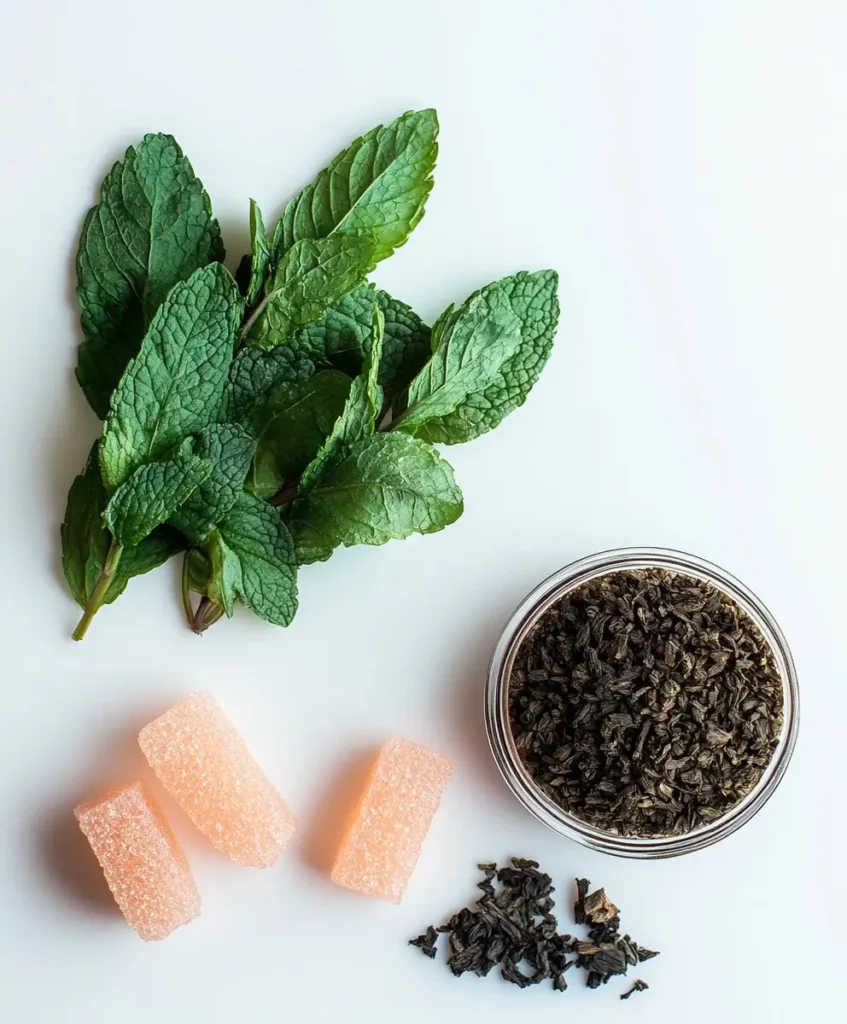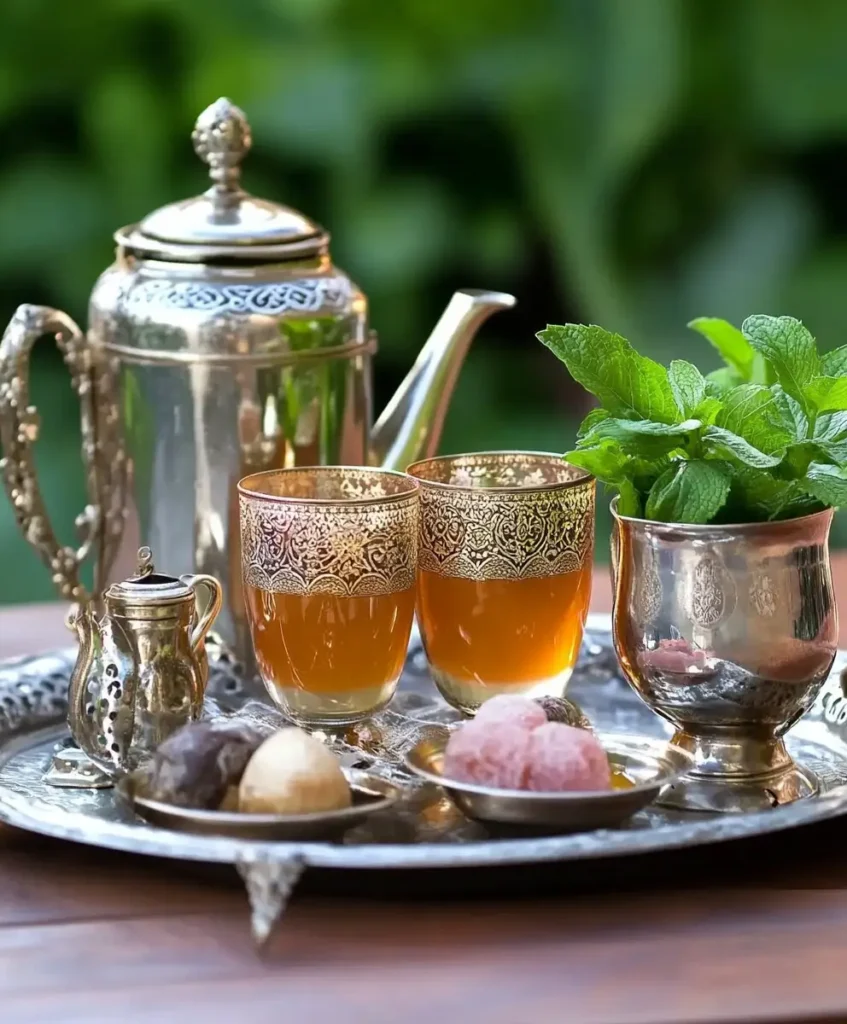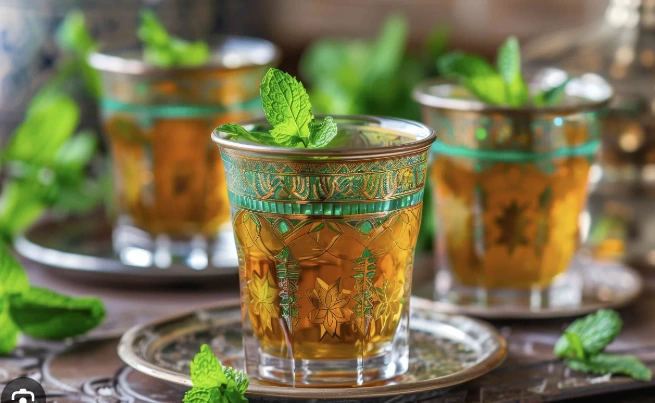Moroccan Mint Tea
Few beverages capture the heart and soul of a culture like Moroccan mint tea. Known locally as atay bi naanaa, this refreshing and aromatic drink offers more than just warmth; it symbolizes hospitality, tradition, and community in Morocco. Families savor it together, hosts serve it to guests, and patrons sip it at bustling cafés. Moroccan mint tea blends flavors and cultural heritage that have enchanted locals and travelers alike for centuries.
At its core, Moroccan mint tea combines three simple ingredients: green tea, fresh mint leaves, and sugar. However, preparing it requires skill and care, reflecting patience and respect for tradition. Hosts serve the tea from ornately decorated teapots, pouring it into small glasses with a flourish. This creates an appealing foam on top, a hallmark of perfect preparation.
People worldwide now celebrate Moroccan mint tea not only for its delicious flavor but also for its soothing and health-boosting properties. It aids digestion, fosters social connections, and transcends borders and cultures.
In this guide, we will explore the history, significance, and preparation of Moroccan mint tea. You will learn about its origins, cultural importance, and how to recreate this iconic beverage at home..
Table of contents
- Moroccan Mint Tea
- The Origins and History of Moroccan Mint Tea
- Cultural Significance of Moroccan Mint Tea
- Ingredients and Tools for Perfect Moroccan Mint Tea
- Step-by-Step Recipe for Moroccan Mint Tea
- Variations of Moroccan Mint Tea
- Tips for Serving Moroccan Mint Tea
- Frequently Asked Questions About Moroccan Mint Tea
- Conclusion
The Origins and History of Moroccan Mint Tea
Moroccan mint tea is more than a drink—it’s a story of trade, culture, and tradition. Its journey to Morocco reflects how global connections can shape local customs.
How Tea Came to Morocco
The history of Moroccan mint tea begins in the 17th century, during the growth of global trade. Green tea, especially the gunpowder type, arrived in Morocco through European traders. These traders traveled on routes linking China, Europe, and North Africa, bringing tea and other goods to new markets.
At first, tea was expensive and only enjoyed by wealthy families. But in the 19th century, European merchants faced a tea surplus and began selling it in North Africa. This made tea more affordable for everyday Moroccans, who soon began brewing it in their own unique way.
The Birth of Moroccan Mint Tea
While green tea was the base, Moroccans added mint to create a drink that matched their tastes. Mint, which grows easily in Morocco, gave the tea a fresh and cool flavor. Sugar, brought to Morocco through trade, added sweetness. These simple ingredients came together to make a drink that is both delicious and special.
Over time, the way Moroccans made and served tea became an art form. Tea was no longer just a drink—it became a way to welcome guests, show respect, and build friendships. Today, Moroccan mint tea is one of the country’s proudest traditions.
Why It’s Important
By the 20th century, Moroccan mint tea was no longer a luxury. It became a daily drink for everyone. Its popularity grew beyond Morocco, spreading to nearby countries in North Africa and even to other parts of the world. Now, it is a symbol of kindness and togetherness.
Cultural Significance of Moroccan Mint Tea
Moroccan mint tea is more than a beverage—it’s a centerpiece of social life and hospitality. Its preparation and serving represent respect, generosity, and a deep cultural tradition that has been passed down for generations.
The Ritual of Tea Serving
In Morocco, serving tea is a ceremonial act that reflects care and attention. The process begins with brewing the tea in a special teapot called a berrad. The host carefully rinses the tea leaves, boils water, and blends green tea with fresh mint leaves and sugar.
The tea is poured into small glasses from a height, creating a frothy layer on top. This signature pour not only cools the tea but also demonstrates the host’s skill. A good foam is considered a sign of well-made tea.
When hosting guests, the preparation of tea is a sign of honor and respect. It shows that the host has taken the time to make something special. Guests often enjoy multiple rounds, as refusing tea might be seen as impolite.
Tea in Social Gatherings
Tea is at the heart of Moroccan hospitality. It’s served at family meals, during celebrations, and when welcoming visitors. Sharing tea is a way to connect with others and build bonds.
In rural areas, tea is often enjoyed outdoors, under the shade of trees, with neighbors and family. In urban settings, it’s common to sip tea in bustling cafés or during lively gatherings. Whether in a humble home or a grand riad, tea always plays a role in bringing people together.
In Moroccan culture, tea is also used to mark important life events, such as weddings and religious celebrations. It’s a drink that signifies unity, friendship, and good fortune.
Symbolism in Moroccan Culture
For Moroccans, mint tea is more than just a drink—it’s a symbol of peace and harmony. The green tea represents strength, the mint leaves reflect freshness, and the sugar signifies the sweetness of life. Together, these elements create a beverage that is as meaningful as it is delicious.
Ingredients and Tools for Perfect Moroccan Mint Tea
To create an authentic Moroccan mint tea experience, you need the right ingredients and tools. Each element plays a crucial role in achieving the tea’s signature taste and presentation.

Green Tea Selection
The foundation of Moroccan mint tea is gunpowder green tea. This type of tea gets its name from the tightly rolled leaves that resemble tiny pellets. It has a bold, slightly smoky flavor that balances the sweetness and minty freshness.
When choosing green tea, quality matters. Look for loose-leaf gunpowder tea, as it provides a more robust flavor than pre-packaged tea bags.
Fresh Mint Leaves
Fresh mint leaves are the heart of Moroccan mint tea. They give the tea its signature aroma and cooling taste. Moroccan spearmint (naanaa) is the traditional choice, but if unavailable, regular mint works as a substitute.
To get the best flavor, use whole, fresh leaves. Wash them thoroughly to remove any dirt or residue before adding them to the teapot.
Sugar and Sweetness
Moroccan mint tea is famously sweet, with sugar being an essential ingredient. Large sugar cubes, often made from raw cane sugar, are traditionally used. The amount of sugar can vary depending on personal preference, but the tea is typically very sweet to highlight its refreshing flavor.
For a healthier alternative, you can use honey or reduce the sugar quantity while still enjoying a delightful taste.
Traditional Moroccan Teapot and Glasses
The tools used to prepare and serve Moroccan mint tea are just as important as the ingredients. A traditional teapot, called a berrad, is designed to withstand direct heat, allowing tea to be brewed and served from the same vessel. These teapots often feature intricate designs and a long spout for high pouring.
The tea is served in small, colorful glasses that are often hand-decorated with gold or silver patterns. These glasses add a touch of elegance and enhance the visual appeal of the tea.
Optional Additions
- Oranges or Lemons: For a citrusy twist, slices of orange or lemon can be added.
- Spices: Some variations include cinnamon or ginger for a warming flavor.
Step-by-Step Recipe for Moroccan Mint Tea
Making Moroccan mint tea is a delightful process that combines precision and artistry. Follow these steps to create an authentic and refreshing beverage at home.
Ingredients Needed
To prepare traditional Moroccan mint tea, gather the following ingredients:
- 2 tablespoons of gunpowder green tea
- 1 large handful of fresh mint leaves (Moroccan spearmint if available)
- 4 tablespoons of sugar (adjust to taste)
- 4 cups of boiling water
Optional: Add slices of lemon, orange, or a pinch of cinnamon for variations.
Preparation Steps
- Rinse the Tea Leaves
- Place the gunpowder green tea in a traditional teapot (berrad).
- Pour about ½ cup of boiling water over the tea leaves, swish gently, and discard the water. This step cleans the leaves and reduces bitterness.
- Brew the Base Tea
- Add 2 cups of boiling water to the teapot and let the tea steep for 2-3 minutes.
- Pour this first brew into a glass and set it aside. This liquid acts as the tea’s concentrated base.
- Cleanse the Tea Leaves Again
- Pour another ½ cup of boiling water over the tea leaves, swish, and discard. This ensures the tea isn’t too strong or bitter.
- Assemble the Tea
- Return the concentrated tea base to the teapot.
- Add the fresh mint leaves and sugar to the teapot. Adjust the sugar based on your preferred sweetness level.
- Mix and Heat
- Fill the teapot with the remaining boiling water. Place it on low heat for 3-5 minutes to allow the flavors to blend. Do not let the tea boil, as it can compromise the flavor.
- Aerate the Tea
- Pour the tea from a height into a glass, then pour it back into the teapot. Repeat this process 2-3 times to mix the ingredients thoroughly and create a foamy top layer.
- Serve and Enjoy
- Pour the tea into small, decorative glasses from a height to maintain the foam. Serve immediately with Moroccan pastries or snacks.
Pro Tips for Perfect Tea
- Balance the Flavors: Taste the tea before serving. Adjust sugar or mint as needed.
- Use Fresh Mint: The fresher the mint, the more aromatic and flavorful the tea will be.
- Pour with Style: Pouring from a height not only aerates the tea but also adds to its authentic presentation.
Variations of Moroccan Mint Tea
While the classic Moroccan mint tea recipe is iconic, many variations add unique twists to this beloved drink. Whether you’re looking for a seasonal spin or a regional touch, these options highlight the versatility of Moroccan mint tea.
Spiced Mint Tea
For a warmer, more aromatic flavor, spices can be added to North African beverage. These spices not only enhance the taste but also provide additional health benefits.
- Cinnamon: Adds a subtle sweetness and warmth, perfect for cold days.
- Ginger: Offers a spicy kick and aids digestion.
- Cardamom or Cloves: Introduce a rich, exotic flavor for special occasions.
To prepare this variation, simply add your chosen spice to the teapot along with the green tea and mint leaves during the brewing process.
Citrus Mint Tea
Citrus fruits like lemon or orange are often used to brighten the flavor of Moroccan mint tea. This variation is especially refreshing during summer or as a morning pick-me-up.
- Add thin slices of lemon or orange peel to the teapot before steeping.
- For a sweeter twist, use mandarin oranges for a fruity touch.
The citrus aroma pairs beautifully with the mint, creating a revitalizing drink that’s both tangy and soothing.
Iced Moroccan Mint Tea
Moroccan mint tea is traditionally served hot, but it can also be enjoyed as a chilled beverage. This version is perfect for summer days when you need something cool and refreshing.
- Brew the tea as usual and allow it to cool to room temperature.
- Add ice cubes and garnish with fresh mint leaves or a slice of lime.
- For an extra layer of flavor, try infusing the tea with a splash of rose water or a drizzle of honey before chilling.
Herbal Variations
For those who prefer caffeine-free options, Moroccan mint tea can be made with herbal infusions instead of green tea. Popular alternatives include:
- Chamomile Mint Tea: A calming drink ideal for evenings.
- Verbena Mint Tea (louisa): A traditional Moroccan herbal blend known for its soothing properties.
- Rosemary or Thyme Mint Tea: Earthy and aromatic, these are perfect for a hearty, herbal twist.
These herbal variations retain the essence of Moroccan tea while offering diverse flavor profiles.
Sweet and Savory Adjustments
While sugar is a key element in North African beverage, modern variations allow for alternative sweeteners like honey or maple syrup. Some people even enjoy their tea less sweet or completely unsweetened to let the natural flavors of the mint and tea shine through.
On the other hand, a savory twist can be achieved by adding a pinch of sea salt, especially in desert regions where salted tea is sometimes preferred.
Regional Variations in Morocco
The way mint tea is prepared can differ from one region of Morocco to another:
- In the Sahara, tea is often served extra sweet with a frothy texture, a practice deeply rooted in nomadic traditions.
- Coastal areas may use a mix of herbs like sage or oregano to enhance the tea’s flavor.
- In the Atlas Mountains, locals sometimes add wild mint or other native herbs for a robust and earthy taste.
Why Explore Variations?
Experimenting with different ingredients and methods allows you to customize Moroccan mint tea to your preferences. Whether you crave warmth, brightness, or chill, there’s a version of Moroccan mint tea to suit every mood and season.
Tips for Serving Moroccan Mint Tea
Serving Moroccan mint tea is an art form steeped in tradition. From the way it’s poured to what it’s served with, attention to detail enhances the experience. These tips will help you serve tea like a true Moroccan host.

Master the Pouring Technique
One of the hallmarks of Moroccan mint tea is the way it’s poured. The technique isn’t just for show—it aerates the tea and creates a frothy layer on top, which is seen as a sign of good preparation.
- How to Pour: Hold the teapot high above the glass, keeping a steady hand to avoid spilling. This height helps cool the tea slightly and ensures the foam forms on the surface.
- Practice Makes Perfect: If you’re new to this, start with a lower pour and gradually increase the height as you gain confidence.
Choose the Right Glasses
Moroccan mint tea is traditionally served in small, colorful glasses that reflect the country’s vibrant culture. These glasses are often adorned with gold or silver patterns.
- Use clear glasses to showcase the beautiful green color of the tea and the mint leaves floating inside.
- If hosting guests, opt for matching sets of glasses for a polished presentation.
Serve in Style with a Tray
In Morocco, tea is typically served on a decorative tray, often made of silver or brass. The tray not only adds elegance but also makes it easy to carry multiple glasses.
- Arrange the teapot, glasses, and sugar cubes neatly on the tray.
- Add a small bowl of fresh mint leaves for guests who want extra flavor.
Pairing Moroccan Mint Tea with Snacks
Tea is often accompanied by light snacks, which can enhance the experience. Some popular pairings include:
- Traditional Moroccan Pastries: Chebakia (honey-coated sesame cookies), ghriba (almond cookies), or briouats (sweet phyllo triangles).
- Dates and Nuts: Sweet dates and roasted almonds are common accompaniments.
- Savory Options: Small bites like olives or mini batbout (Moroccan flatbread) can provide a contrast to the tea’s sweetness.
Offering a variety of snacks allows guests to enjoy a balanced mix of flavors.
Timing Matters
The time you serve Moroccan mint tea can add meaning to the occasion:
- Welcome Ritual: Tea is often the first thing served to guests upon arrival, symbolizing hospitality.
- Post-Meal Delight: Serve tea after meals to aid digestion and cleanse the palate.
- Evening Relaxation: Tea is also enjoyed in the evening as a way to unwind with family and friends.
By aligning the tea service with the occasion, you can create a more memorable experience.
Pay Attention to Presentation
The beauty of Moroccan mint tea lies not only in its taste but also in its presentation. To create a visually appealing setup:
- Garnish each glass with a small sprig of mint for a fresh touch.
- Use a clean and polished teapot and tray to reflect the care you’ve put into the preparation.
- Place a colorful tablecloth or decorative elements under the tray to enhance the overall ambiance.
Why Serving Matters
In Moroccan culture, the way tea is served is as important as its preparation. It’s a moment to slow down, connect, and show gratitude to your guests. Taking the time to serve tea thoughtfully creates a warm and inviting atmosphere.

Moroccan Mint Tea
Ingredients
- 1 tbsp green tea preferably Chinese gunpowder tea
- 1 handful fresh mint leaves
- 3 cups water
- 3-4 tbsp sugar adjust to taste
Instructions
- Boil Water – Bring 3 cups of water to a boil.
- Rinse the Tea – Add the green tea to a teapot and pour a little boiling water over it. Swirl for a few seconds, then discard this first rinse to remove bitterness.
- Brew the Tea – Pour the rest of the hot water over the tea leaves and let it steep for 2-3 minutes.
- Add Mint & Sugar – Add the fresh mint leaves and sugar directly into the teapot.
- Mix the Tea – To mix, pour the tea into a glass and then back into the teapot a couple of times.
- Serve – Pour from a height to create foam, a signature touch of Moroccan tea service. Enjoy!
Notes
- Adjust sugar to your preference or use honey for a healthier version.
- Traditionally served in small glasses, Moroccan tea is best enjoyed hot and fresh.
Frequently Asked Questions About Moroccan Mint Tea
To wrap up this guide, here are answers to some of the most common questions about Moroccan mint tea. These insights will help deepen your understanding of this beloved drink.
Can I Make Moroccan Mint Tea Without Sugar?
Yes, you can! While traditional Moroccan mint tea is sweetened with sugar, you can adjust or eliminate the sugar to suit your taste. For a healthier alternative, consider using honey or a natural sweetener like stevia. Unsweetened tea allows the bold flavors of the green tea and mint to shine through.
How Long Does It Take to Brew Moroccan Mint Tea?
Preparing Moroccan mint tea typically takes around 10–15 minutes. This includes rinsing the tea leaves, brewing the base tea, and allowing the mint and sugar to infuse. Although the process is slightly longer than making standard tea, the results are worth the effort.
Is It Safe to Drink Moroccan Mint Tea Every Day?
Drinking Moroccan mint tea daily is generally safe and can even be beneficial. The antioxidants in green tea and the soothing properties of mint can promote overall health. However, if you are sensitive to caffeine or consume large amounts of sugar, you may want to moderate your intake or use a caffeine-free herbal tea base.
Can I Use Other Types of Tea to Make Moroccan Mint Tea?
Although gunpowder green tea is traditional, you can experiment with other tea bases. For a caffeine-free option, try chamomile or verbena (louisa). If you prefer a stronger flavor, black tea can also be used. Each variation brings a new twist to this classic drink while maintaining its essence.
What Is the Ideal Temperature for Brewing Moroccan Mint Tea?
The ideal brewing temperature for green tea is around 175–185°F (80–85°C). Boiling water can scorch the tea leaves, leading to a bitter taste. If you’ve boiled your water, let it cool for a minute before pouring it over the tea leaves to achieve the best flavor.
Where Can I Buy Authentic Ingredients for Moroccan Mint Tea?
You can find gunpowder green tea, fresh mint, and traditional Moroccan teapots at Middle Eastern or North African grocery stores. Many online retailers also offer Moroccan tea sets and ingredients. For the freshest mint, consider growing it at home in a small herb garden.
Bonus Tips for Tea Enthusiasts
- Experiment with ratios of mint, tea, and sugar to find the balance that suits your preferences.
- If you’re serving tea to guests, always refill their glasses as a gesture of respect and hospitality.
Conclusion
Moroccan Mint Tea is more than just a drink; it’s a cultural experience that embodies warmth, hospitality, and tradition. Whether you enjoy it for its refreshing taste or its numerous health benefits, this tea is a staple in Moroccan households and beyond. To fully embrace the Moroccan tea ritual, pair it with traditional Moroccan Msemmen, a flaky, buttery flatbread that perfectly complements the sweetness and aroma of mint tea.
